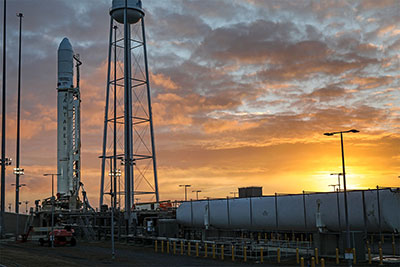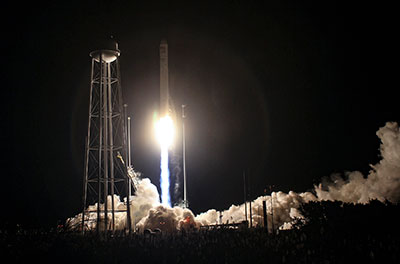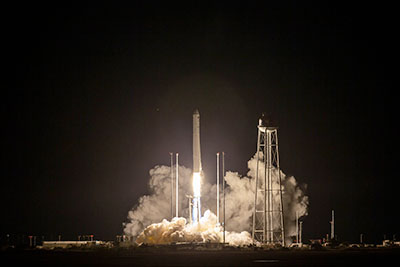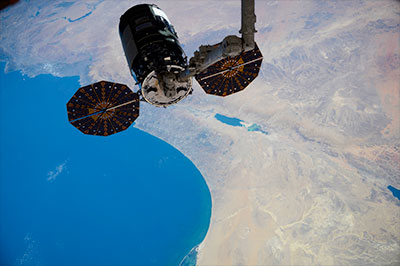|
|

|
|
Author
|
Topic: Northrop Grumman Cygnus NG-14 CRS flight
|
Robert Pearlman
Editor Posts: 45477
From: Houston, TX
Registered: Nov 1999
|
 posted 09-08-2020 05:36 PM
posted 09-08-2020 05:36 PM
   
collectSPACE Cargo spacecraft named for fallen NASA astronaut Kalpana ChawlaA commercial cargo spacecraft bound for the International Space Station will fly under the name of a fallen NASA astronaut who was the first Indian-born woman to enter space. Northrop Grumman has announced that its next Cygnus capsule will be named the "S.S. Kalpana Chawla," in memory of the mission specialist who died with her six crewmates aboard the space shuttle Columbia in 2003.  |
Robert Pearlman
Editor Posts: 45477
From: Houston, TX
Registered: Nov 1999
|
 posted 09-28-2020 09:18 AM
posted 09-28-2020 09:18 AM
   
Northrop Grumman release Northrop Grumman Set to Launch 14th Cargo Delivery Mission to the International Space StationS.S. Kalpana Chawla spacecraft ready for liftoff aboard an Antares rocket carrying vital supplies and equipment for the crew aboard the station Northrop Grumman Corporation is set to launch the company's 14th resupply mission (NG-14) to the International Space Station under NASA's Commercial Resupply Services-2 contract. The NG-14 mission's Cygnus spacecraft will launch aboard the company's Antares rocket with nearly 8,000 pounds (approximately 3,600 kg) of scientific research, supplies and hardware for the astronauts aboard the station. Liftoff of the Antares rocket is scheduled for Oct. 1 at 9:38 p.m. EDT from the Mid-Atlantic Regional Spaceport Pad 0A on Wallops Island, at NASA's Wallops Flight Facility. A secondary mission is also planned for Cygnus once it leaves the space station in approximately three months. The spacecraft hosts the Northrop Grumman-built SharkSat payload and will perform the Saffire–V experiment. The S.S. Kalpana Chawla will remain attached to the ISS for approximately three months before departing with up to 8,200 pounds (approximately 3,720 kilograms) of disposal cargo.  |
Robert Pearlman
Editor Posts: 45477
From: Houston, TX
Registered: Nov 1999
|
 posted 10-02-2020 10:54 AM
posted 10-02-2020 10:54 AM
   
Northrop Grumman update The launch of the Antares rocket carrying the Cygnus spacecraft is now scheduled for Friday, Oct. 2, at 9:16 p.m. EDT from Wallops Island, Virginia.The Oct. 1, launch attempt was scrubbed after receiving off-nominal data from ground support equipment. |
Robert Pearlman
Editor Posts: 45477
From: Houston, TX
Registered: Nov 1999
|
 posted 10-03-2020 10:31 AM
posted 10-03-2020 10:31 AM
   
Northrop Grumman release Northrop Grumman Successfully Launches 14th Cargo Delivery Mission to the International Space StationNorthrop Grumman Corporation successfully launched the company's Cygnus cargo resupply spacecraft, the S.S. Kalpana Chawla, to the International Space Station.  "As our experience has grown with each Antares mission, we have improved efficiencies, evolved technologies and increased lift capabilities, flying nearly 90,000 pounds of cargo to the International Space Station to date," said Scott Lehr, vice president and general manager, launch and missile defense systems, Northrop Grumman. After the nine minute ascent, the S.S. Kalpana Chawla, named for the first woman of Indian descent to fly in space, was deployed into orbit. Approximately two and a half hours later, the vehicle's Ultra-flex solar arrays successfully deployed, and the spacecraft is currently operating nominally. Cygnus is scheduled to be grappled by the crew on the International Space Station on Oct. 5 at approximately 5:20 a.m. EDT. |
Robert Pearlman
Editor Posts: 45477
From: Houston, TX
Registered: Nov 1999
|
 posted 10-03-2020 10:38 AM
posted 10-03-2020 10:38 AM
   
NASA release NASA Science, Cargo Heads to Space Station on Northrop Grumman Resupply MissionA Northrop Grumman Cygnus resupply spacecraft is on its way to the International Space Station with nearly 8,000 pounds of scientific investigations, technology demonstrations, commercial products, and other cargo after launching at 9:16 p.m. EDT Friday (Oct. 2) from NASA's Wallops Flight Facility on Wallops Island, Virginia.  The spacecraft launched on an Antares rocket from the Virginia Mid-Atlantic Regional Spaceport's Pad 0A at Wallops and is scheduled to arrive at the space station around 5:20 a.m. Monday, Oct. 5. Expedition 63 Commander Chris Cassidy of NASA will use the space station's robotic arm to capture Cygnus, while Ivan Vagner of Roscosmos monitors telemetry during rendezvous, capture, and installation on the Unity module's Earth-facing port. Cygnus will remain at the space station until mid-December before it disposes of several thousand pounds of trash as it burns up during a safe re-entry into Earth's atmosphere. This delivery – Northrop Grumman's 14th contracted cargo flight to the space station and the third under its Commercial Resupply Services 2 contract with NASA – will support dozens of new and existing investigations. Included aboard Cygnus for delivery to the space station are: - Improving how we 'go' in space
A new toilet is headed to the space station. Its features improve on current space toilet operations and help NASA prepare for future missions, including those to the Moon and Mars. The Universal Waste Management System (UWMS) demonstrates a compact toilet and the Urine Transfer System that further automates waste management and storage. The smaller footprint of the UWMS supports a possible increase in the number of crew members aboard the space station, as well as planning for future exploration missions. - Energy and water from waste
The investigation Elucidating the Ammonia Electrochemical Oxidation Mechanism via Electrochemical Techniques at the ISS (Ammonia Electrooxidation) examines a process for ammonia oxidation in microgravity. An electrochemical ammonia removal system could serve as an innovative water recovery system on long-duration missions to the Moon and Mars and provide vital drinkable water in remote and arid areas on Earth. - Adding radishes to the space salad
A new crop of vegetables is headed to the space station. While previous experiments have grown different types of lettuces and greens aboard the orbiting laboratory, the Assessment of Nutritional Value and Growth Parameters of Space-grown Plants (Plant Habitat-02) investigation adds radishes to the mix, cultivating seeds to see how different light and soil conditions affect growth. Findings could help optimize growth of the plants in space, as well as provide an assessment of their nutrition and taste. - Identifying targeted cancer treatments
The Leveraging Microgravity to Screen Onco-selective Messenger RNAs for Cancer Immunotherapy (Onco-Selectors) investigation tests drugs based on messenger ribonucleic acids (mRNA) for treating leukemia. In normal gravity, the drugs to be tested are onco-selective, meaning they can distinguish cancer cells from healthy ones. Researchers expect any drugs that also demonstrate this trait in microgravity could make good candidates for safer, more effective, and affordable medicines to treat leukemia and other cancers. This could improve survival rates for thousands of people every year. - Spacewalks in virtual reality
The International Space Station Experience (ISS Experience) is creating an immersive virtual reality series documenting life and research aboard the space station. Partnering with the ISS National Lab and TIME, a team from Felix and Paul Studios launched a customized 360-degree camera to the space station in December 2018 that crew members have used to record a few hours inside the station every week. Felix and Paul and partner NanoRacks further modified an additional camera to withstand the extreme conditions of space and are launching for use in filming a spacewalk. The new camera will be mounted to the Canadarm2 to capture a spacewalk from start to finish as well as footage of Earth and the exterior of the space station.
These are just a few of the hundreds of investigations currently being conducted aboard the orbiting laboratory in the areas of biology and biotechnology, physical sciences, and Earth and space science. Advances in these areas will help to keep astronauts healthy during long-duration space travel and demonstrate technologies for future human and robotic exploration beyond low-Earth orbit to the Moon and Mars through NASA's Artemis program.In addition to science and research, this launch will also support commercial space endeavors. Estée Lauder's New Advanced Night Repair serum will be photographed in the space station's iconic cupola window as part of NASA's efforts to enable commercial activities at the space station and develop a robust low-Earth orbit economy. The imagery will be used on the brand's social media platforms. These opportunities can help catalyze and expand space exploration markets for many businesses. The Cygnus spacecraft for this resupply mission is named in honor of Kalpana Chawla, who made history at NASA as the first female astronaut of Indian descent. Chawla, who dedicated her life to understanding flight dynamics, lost her life during the STS-107 mission when the space shuttle Columbia disintegrated upon reentering Earth's atmosphere. |
Robert Pearlman
Editor Posts: 45477
From: Houston, TX
Registered: Nov 1999
|
 posted 10-05-2020 09:27 AM
posted 10-05-2020 09:27 AM
   
Northrop Grumman release Northrop Grumman's Cygnus Spacecraft Berths with International Space StationNorthrop Grumman Corporation's Cygnus spacecraft was successfully captured by commander Chris Cassidy of NASA using the International Space Station's robotic Canadarm2 at 5:32 a.m. EDT on Monday (Oct. 5) after its launch on the company's Antares rocket on Oct. 2 from Wallops Island.  The S.S. Kalpana Chawla executed a series of thruster burns during its three day journey to the station. Once Cygnus was in close range, crew members grappled the spacecraft with the station's robotic arm. Cygnus was then guided to its berthing port on the Earth facing side of the station's Unity module and officially installed to the space station at 8:01 a.m. EDT. "The S.S. Kalpana Chawla has successfully completed the first part of its mission with its arrival at the International Space Station," said Frank DeMauro, vice president and general manager, tactical space systems, Northrop Grumman. "Northrop Grumman is proud to support both NASA and our commercial partners as we continue to play a critical role in support of humans living and working in space." Cygnus will remain berthed to the International Space Station for approximately three months while more than 8,000 pounds of cargo is unloaded and astronauts reload the vehicle with disposal cargo. Cygnus will then undock and complete its secondary mission of hosting both the Northrop Grumman-built SharkSat payload and the Saffire-V experiment. The SharkSat prototype payload is mounted to Cygnus and will collect performance data of new technologies in low Earth orbit.  |
Robert Pearlman
Editor Posts: 45477
From: Houston, TX
Registered: Nov 1999
|
 posted 01-06-2021 09:44 AM
posted 01-06-2021 09:44 AM
   
Northrop Grumman release Northrop Grumman's NG-14 Cygnus Spacecraft Completes Primary Mission to the International Space StationNorthrop Grumman Corporation announced today (Jan. 6) that the company has completed the first phase of its 14th cargo resupply mission to the International Space Station under NASA's Commercial Resupply Mission (CRS-2) contract. Cygnus was released by the station's robotic arm at 10:11 a.m. ET, carrying more than 4,000 pounds of disposable cargo and will remain in orbit for approximately two weeks for the secondary phase of its mission.  "For more than six years, Northrop Grumman has supported human spaceflight by delivering critical cargo to astronauts aboard the International Space Station and acting as a host to a number of science experiments and technology demonstrations," said Frank DeMauro, vice president and general manager, tactical space systems, Northrop Grumman. "Our Cygnus spacecraft will once again demonstrate the capabilities and flexibility we offer our customers by conducting critical experiments during our secondary mission phase." Cygnus' secondary mission includes conducting NASA's Spacecraft Fire Safety Experiment V (Saffire-V) experiment, which helps researchers understand how fire behaves in microgravity, and hosting the SharkSat payload. SharkSat is a Northrop Grumman-developed prototype payload mounted to the Cygnus spacecraft that will provide data about the performance of key technologies in a space environment for future missions. SharkSat is driving rapid innovation in technology development and growing Northrop Grumman's next generation of technical leaders. The "S.S. Kalpana Chawla", launched Oct. 2 aboard Northrop Grumman's Antares rocket, carrying nearly 8,000 pounds (approximately 3,600 kg) of scientific research, supplies and equipment to astronauts living on the station. The vehicle has been docked with the orbiting laboratory since Oct. 5. |
Robert Pearlman
Editor Posts: 45477
From: Houston, TX
Registered: Nov 1999
|
 posted 01-26-2021 04:07 PM
posted 01-26-2021 04:07 PM
   
Northrop Grumman update That's a wrap! With the completion of the S.S. Kalpana Chawla's secondary mission, our 14th cargo resupply for NASA has concluded.The NG-14 Cygnus spacecraft completed its mission on Jan. 26 at 3:23 p.m. EST. | |
Contact Us | The Source for Space History & Artifacts
Copyright 2021 collectSPACE.com All rights reserved.

Ultimate Bulletin Board 5.47a
|
|

|
 advertisement advertisement

|


















